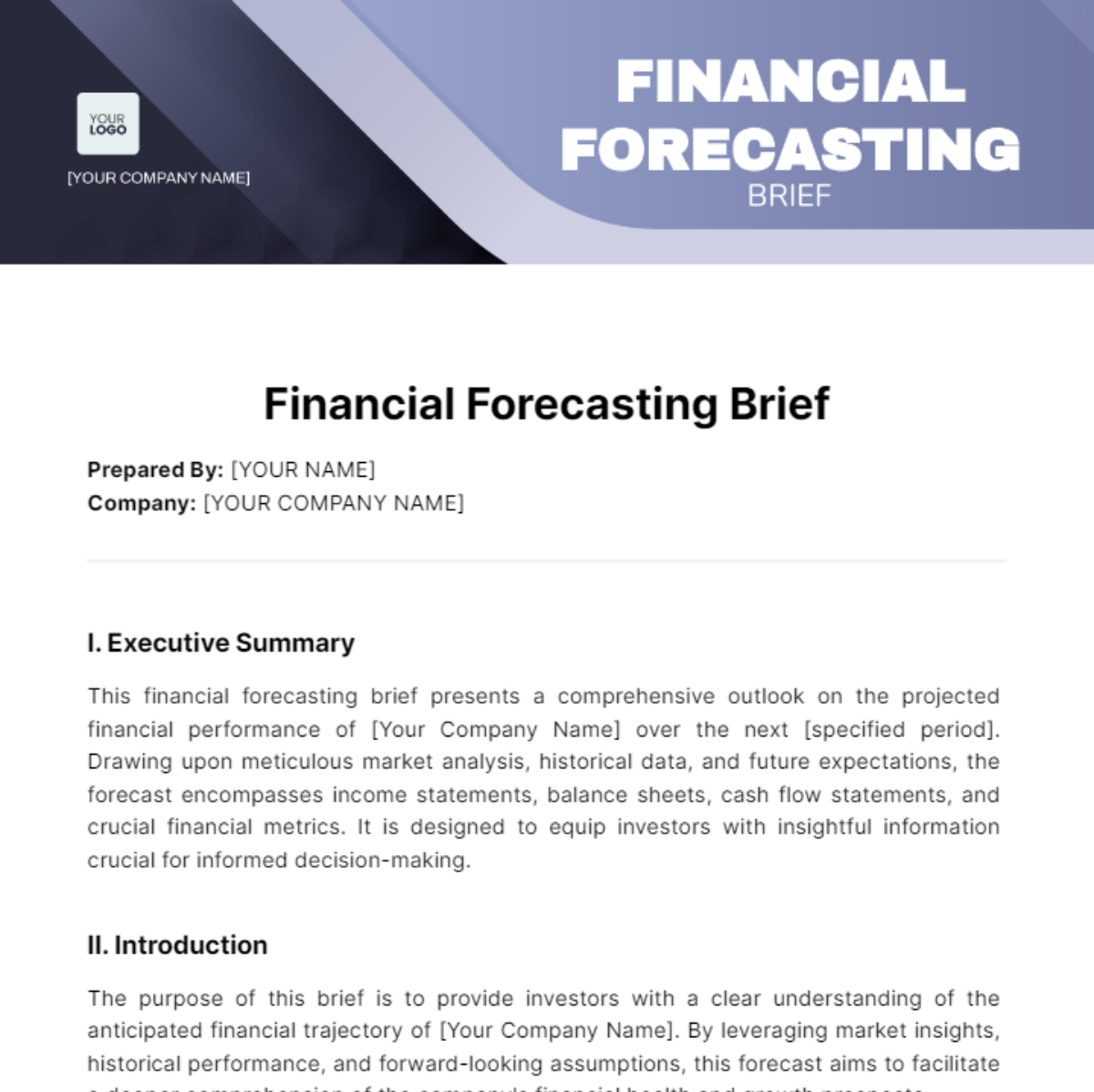Free Financial Forecasting Brief

Prepared By: [YOUR NAME]
Company: [YOUR COMPANY NAME]
I. Executive Summary
This financial forecasting brief presents a comprehensive outlook on the projected financial performance of [Your Company Name] over the next [specified period]. Drawing upon meticulous market analysis, historical data, and future expectations, the forecast encompasses income statements, balance sheets, cash flow statements, and crucial financial metrics. It is designed to equip investors with insightful information crucial for informed decision-making.
II. Introduction
The purpose of this brief is to provide investors with a clear understanding of the anticipated financial trajectory of [Your Company Name]. By leveraging market insights, historical performance, and forward-looking assumptions, this forecast aims to facilitate a deeper comprehension of the company's financial health and growth prospects.
III. Assumptions
Aspect | Assumptions |
|---|---|
Market Trends | Assumed growth rates and trends in the relevant industry segment based on thorough market analysis. |
Economic Environment | Assumptions about macroeconomic factors such as interest rates, inflation, and GDP growth. |
Company Strategy | Expectations regarding strategic initiatives, product launches, and expansion plans. |
Cost Structure | Assumptions about operational costs, including materials, labor, and overhead expenses. |
Competitive Landscape | Anticipated competitive pressures and their impact on pricing and market share. |
IV. Historical Data
Detailed historical financial data for [Your Company Name] including income statements, balance sheets, and cash flow statements are provided as a basis for comparison and context for the forecast.
V. Forecasted Financial Statements
Projected Income Statement: Forecasting revenues, expenses, and net income over the specified period.
Projected Balance Sheet: Estimating assets, liabilities, and equity at the end of each period.
Projected Cash Flow Statement: Predicting cash inflows and outflows to evaluate liquidity and financing needs.
VI. Key Metrics and Ratios
Gross Margin
Earnings Before Interest, Taxes, Depreciation, and Amortization (EBITDA)
Return on Investment (ROI)
Debt-to-Equity Ratio
Current Ratio
VII. Sensitivity Analysis
Conduct sensitivity analysis to assess the impact of variations in key assumptions on the forecasted financial statements. This will help identify potential risks and uncertainties that could affect the company's performance.
VIII. Conclusion
In conclusion, this financial forecasting brief offers a comprehensive outlook on the anticipated financial performance of [Your Company Name]. By integrating market insights, historical data, and forward-looking assumptions, investors can gain valuable insights into the company's growth prospects and financial health.
IX. Recommendation
Based on the forecasted outcomes and identified sensitivities, it is recommended that investors closely monitor key market indicators and reassess their investment strategies periodically. Additionally, maintaining a diversified portfolio can help mitigate risks associated with unforeseen changes in market conditions.
- 100% Customizable, free editor
- Access 1 Million+ Templates, photo’s & graphics
- Download or share as a template
- Click and replace photos, graphics, text, backgrounds
- Resize, crop, AI write & more
- Access advanced editor
Plan your financial future with Template.net's Financial Forecasting Brief Template. This editable and customizable template assists in projecting financial outcomes, providing clarity and direction. Adjust it to suit your unique business model using our intuitive Ai Editor Tool. Forecast with confidence and precision effortlessly, enabling informed decision-making and strategic planning for long-term financial success and stability.





























